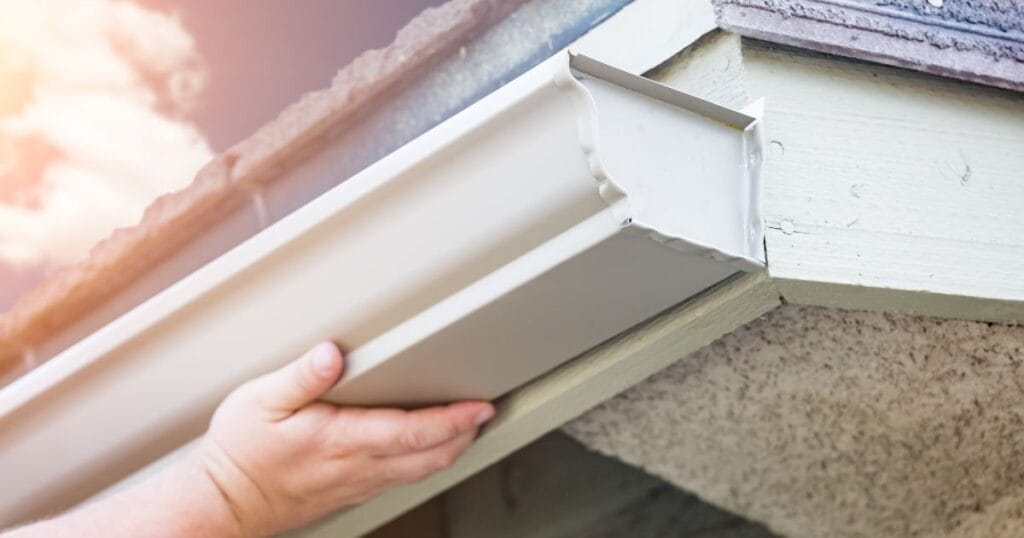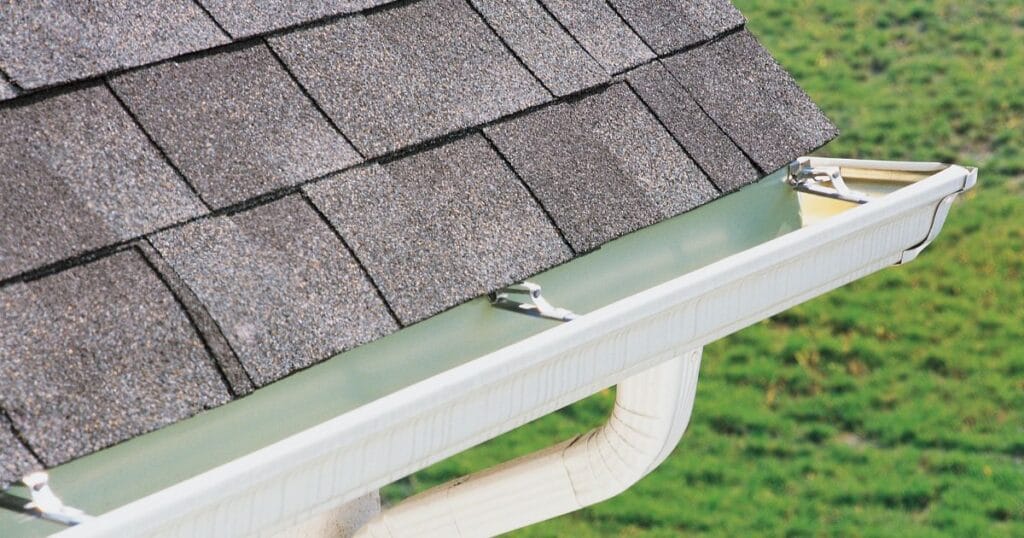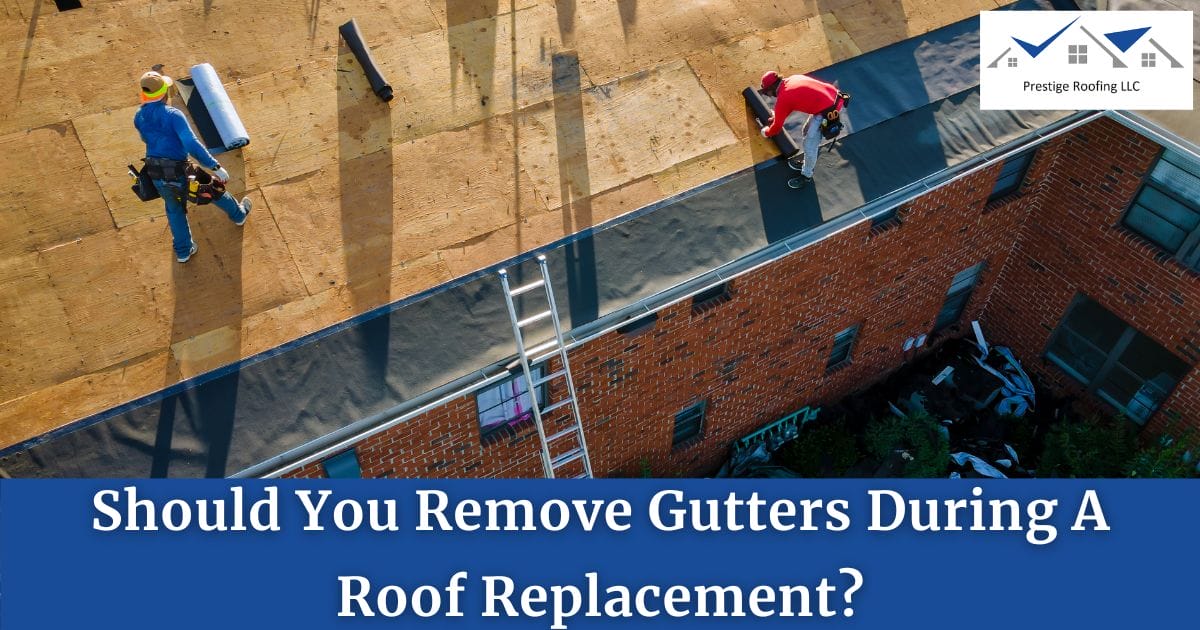Replacing your home’s roof is a major undertaking. It guarantees the stability of your house and keeps it safe from the elements. However, you might be wondering if removing the gutters is a necessary step in getting a new roof.
In this blog post, we’ll look at the benefits and drawbacks of gutter removal during roof work and discuss the factors you should consider when making a final decision.
When Replacing A Roof, Should The Gutters Be Removed?
Gutters are a common consideration for homeowners getting a new roof. The gutter system usually doesn’t need to be taken out unless components are damaged or broken. Throughout the process, roofing contractors take precautions to keep them safe. If necessary, gutter problems, such as replacements or repairs, are usually handled after the roof replacement is complete. This guarantees the gutters and roof are in good condition and facilitates a smooth process.
If your gutters are still in good condition, there’s no rush to replace them when installing the new roof. If you’re unsure, it’s a good idea to consult with a professional. They can assess the gutters and advise if replacement is needed alongside the roof.
Also Read: Choosing The Right Gutters For Your Home: A Complete Guide
Pros And Cons
Now that you know it is not necessary to remove gutters during a roof replacement, it is also important that you know the pros and cons so you make a well thought decision for your home. Let’s delve in to get a better understanding:
Pros of Removing Gutters During a Roof Replacement

1. Enhanced System Integration:
When replacing gutters alongside the roof, it allows for the installation of an upgraded system, which is particularly beneficial when opting for a seamless gutter system.
2. Protection Against Debris:
During a roof replacement, debris can potentially damage or block gutters. Temporarily removing the gutters safeguards them from such risks, ensuring they remain undamaged and free from clogs.
3. Thorough Roof Inspection:
Removing the gutters creates an opportunity for a thorough inspection of the roof deck and fascia boards. This allows for the prompt resolution of any underlying issues, such as rot or deterioration, thereby contributing to the overall longevity of the roofing system.
4. Contemporary Appearance:
Choosing to completely omit gutters can give a home a modern and minimalist aesthetic. Some homeowners may favor this sleek and simple look, especially when aiming for a contemporary architectural style. However, weigh positives and negatives of not having a gutter system before deciding.
Cons of Removing Gutters During a Roof Replacement
1. Cost Increase:
Replacing gutters alongside a roof replacement can make the project more expensive, especially if there are extra repairs like fixing rotted fascia.
2. Time and Effort:
Removing and reinstalling gutters can prolong the project and require more work, potentially delaying the roof replacement and increasing labor costs.
3. Potential for Misalignment:
Putting the gutters back after a roof replacement might lead to misalignment or poor installation, causing problems like leaks or inadequate drainage.
Risks of Not Having a Gutter System
If you choose to remove the gutters during a roof replacement and not reattach them, you may face these consequences:
1. Water Damage:
Gutters are essential for guiding rainwater away from a home’s foundation. Without them, water accumulation near the foundation can lead to erosion, mold, and structural damage over time.
2. Basement Flooding:
Without gutters, rainwater can flow directly off the roof and pool around the foundation, increasing the chances of basement flooding, especially during heavy rain or in areas prone to water buildup.
3. Landscaping Damage:
A lack of gutters can harm any landscaping near the house by eroding soil, damaging plants, and creating unsightly puddles.
4. Lower Home Value:
Homes without gutters may seem less attractive to potential buyers due to the higher risk of water damage and maintenance issues, potentially reducing the property’s resale value.
5. Health Hazards:
Water-related problems from missing gutters can create conditions favorable for mold growth and pest infestations, posing health risks to occupants and affecting the home’s structure over time.
Factors to Consider When Deciding to Replace Your Gutters During a Roof Replacement
If you are thinking of removing your gutters during a roof replacement, it is crucial that you know when it is right to do so. Consider the following:

1. Assess Gutter Condition:
It’s essential to examine your gutters for signs of wear and tear, like rust, leaks, or sagging, to determine if they need to be replaced. If they’re in good shape and effectively diverting water, replacement may not be necessary. However, significant issues compromising their function might warrant replacement to avoid future problems.
2. Inspect for Roof Damage:
Before replacing the gutters, inspect the roof for any damage that could affect the new installation. Addressing roof issues beforehand ensures a stable foundation for the gutter system and avoids future complications.
3. Choose the Right Gutter Size:
Properly sized gutters are vital for efficient water drainage. During the roof replacement, assess if your current gutter size can handle water flow from the new roof. Upgrading or adjusting gutter size can enhance water management and system performance.
4. Consider Age and Condition:
If the gutters are relatively new and in good condition, removing them may not be necessary. However, older or deteriorating gutters may benefit from inspection and maintenance during the roof replacement.
5. Budget and Maintenance Considerations:
Factor in your budget and long-term maintenance needs when deciding on gutter removal. While initial costs may increase, addressing issues during the roof replacement can prevent future expenses.
Conclusion
When it comes to deciding whether to take off the gutters during a roof replacement, there isn’t a one-size-fits-all answer. It depends on factors like how old your gutters are, their condition, and what kind of roof you’re installing. Removing gutters can be good because it protects them and lets you check for any problems. But it can also cost more and cause some inconvenience. That’s why it’s a good idea to talk to roofing experts like the team at Prestige Roofing. They can help you figure out what’s best for your home and make sure your gutter system stays strong for years to come.
With Prestige Roofing’s free estimate and inspection, your gutter project will be off to a great start. With more than 2,000 completed jobs under our belt and over 50 years of combined experience, we can tackle any roofing project. Open communication, client satisfaction, and project transparency are our top priorities. Additionally, you can be sure that your investment will be well-maintained and worry-free with our 10-year labor warranty. For the best gutter replacement services, give us a call at (920) 791-0414.

